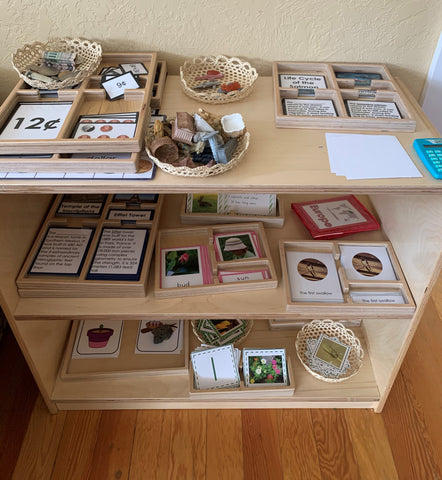
Montessori Principles in the Time of Coronavirus
April 6, 2020
A new week is upon us, and Montessori 123 is learning how to be in the times of COVID-19. We want to help families and support them in this time. We want to stay in business. We need to pay rent at an office we are legally not allowed to go to.
But our priority is to the community. Each and every community has been affected, and we now need to put aside future fears and use our creativity to form adaptive strategies. Although my husband and I are both trained as educators, we are finding how challenging it is to create schedules and teach our children at home. We are learning, just like everyone is, how to exist day to day and how to use the Montessori Principles at home with a classroom of two. Rather than pretending that we have all the answers we have been enjoying sharing our personal story and passing along the resources we've been using.
We wanted to share our take on the Montessori Principles. See if you can choose one tidbit and try to work on it today. Many of these ideas can be read further on the Indiana Montessori Academy website.
Movement in their learning
Where it is possible this encourages all their senses to be a part of the learning experience. In our home we have set up activities through out the house, and they go and get the materials and set it up where they learn best. Movement and learning go hand in hand.
Choice in their learning
When we set out the week and daily schedule I allow my girls to choose. We have work periods, and within those periods it is up to them what they want to learn about. We also do this with clothing options and eating. Choice gives them the power and control they desire.

Interest from the individual child (intrinsic vs extrinsic learning)
This basically means to find topics that interest your child. Don’t bribe them to learn something if they don’t want to. Negotiate how they want to learn about a specific subject and follow that.
Example: My kids really love learning about the science of candy making, so we’re doing an entire unit on it. We're bringing in math, science, language, and culture in as many different angles as possible until they are done learning about candy making.
Learning with and from peers
This is slightly trickier now in isolation, but as a family we are all working to learn from each other.
Recently a dear friend recommended each family member choose a topic. You research that topic, and then teach your family about it. We have started our own family units, so we all study together and share what we learned via FaceTime with the grandparents.
We've shared everything from Star Wars to Legos, My Little Pony, and candy. We are building a garden, so the whole family is learning about gardening in the Methow Valley, Washington. Our excitement over the research is contagious, or at least that's the hope!
Learning in Context
The child is able to learn concepts that are relate-able to them. One of our daughters recently studied native animals of the Methow, and she chose to learn about the chipmunk. We made paper mache animals, noticed adaptive characteristics on the animals body, and researched why animals have specific body parts in order to live in specific habitats. She is seriously SO excited about chipmunks right now.
Child-led learning
Allow the child independence in their learning; let them struggle a bit to find the answers to the problems just long enough for them to learn from this experience. Step in and give some direction towards answers only once they begin to get frustrated. There is definitely an art to toeing that fine line.
"The ideal in the Montessori classroom is for the student to identify, engage in and pace their own learning independently, with the teacher available to guide them and teach them in just the right amount.”

Order in Environment
A calm and orderly environment is a place where children can thrive and know what to expect. We want children to know everything has a place, because this gives them confidence and knowledge of where to return items after they have used them. As teachers our most important goal is to arrange the environment in a way that makes learning accessible. The children then know it is their environment to learn in and take care of.
I have recently organized our home into a classroom like environment. My goal is to share with my girls that each shelf has certain materials and projects that we are working on. When we are done with these projects we return them to the shelves where they belong. We each have our own space we are in charge of keeping organized and tidy.
--
Now here's the giant caveat that, of course, the above principles are applied in an ideal setting, and two growing and changing kids cooped up together with their parents is far from that. We're doing our best to convey the very human side of this whole process, and we love reading and interacting with our community online. Stay strong, friends!
-Megan and the Montessori 123 Team



Leave a comment